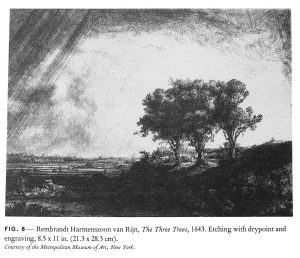Christophe Girot and Dora Imhof, editors
Princeton Architectural Press, 2016
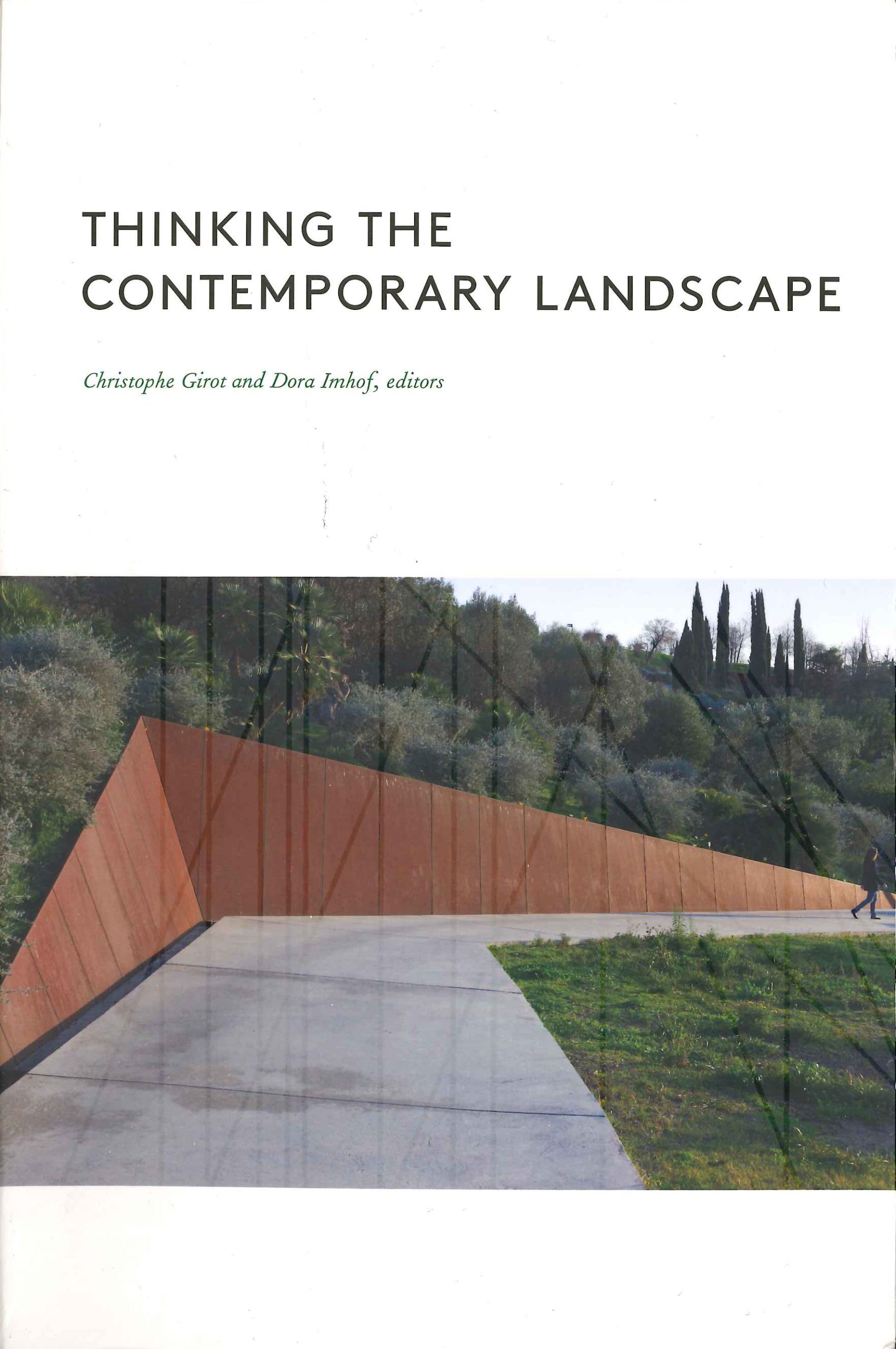
Thinking the Contemporary Landscape, an edited volume by Christophe Girot and Dora Imhof, seeks to present an antidote to the theoretical and disciplinary discourse that has emerged in landscape architecture over the last three decades by refocusing the contemporary conversation toward human perception and aesthetics. Published by Princeton Architectural Press, the seventeen-essay collection attempts to offset a lineage of ecologically focused edited volumes and theory readers by the same publisher, such as Recovering Landscape (1999), The Landscape Urbanism Reader (2006), and Large Parks (2007), which have become influential literary resources in academia and practice. Sharing familiar authors while contributing a new and rich array of voices, Thinking the Contemporary Landscape departs from the contents of its predecessors by reorienting the disciplinary discussion toward experiential rather than process-oriented design, contributing to the growing and evolving collection of critical perspectives questioning the perception, design, and construction of landscape.
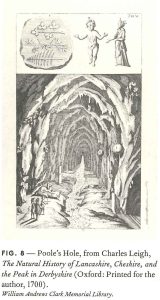
The book is a reactionary call for aesthetics and the poetics of human experience to play a stronger role within contemporary landscapes. Authors such as Elizabeth Meyer (“Performance of Appearance,” 2008) and Anita Berrizbeitia (“Scales of Undecidability,” 2001) have discussed this dilemma between open versus static landscape processes and design precision in their work.1 Girot and Imhof state in their introduction that they seek to “identify aesthetic concerns that, recently, have all too often been overshadowed by a positivistic scientific discourse about nature,” contrasting “the current discourse with a more philosophical and poetic stance” (7.) The editors are referring to the aforementioned theory readers, whose authors broadly advocate for systems-based, process-oriented design approaches to landscape architecture and the integration of science-based research, ecology, and information. Organizations and certifications associated with the “green” building industry, such as LEED (Leadership in Energy and Environmental Design), seek to quantify sustainability, resulting in many projects driven by a numbers game. These perspectives and approaches toward open-ended, technologically based design have proliferated through the discipline in both pedagogy and practice. The editors set out to counterbalance the scale by charging authors to shift the tide towards aesthetics, memory, and human experience in the context of contemporary landscape discourse and global challenges, recognizing that all landscapes are intentionally and unintentionally constructed: ideologically, culturally, and physically.
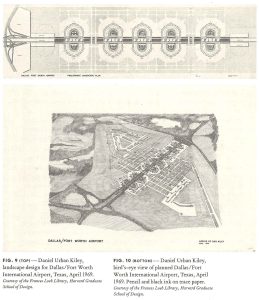
The second section, “Landscape Composed,” investigates how specific working methods yield certain aesthetics in both representation and design. It illuminates current disciplinary struggles with considering local versus global scales, negotiating aesthetics and materiality across those scales, and creating meaningful cultural sites with larger-scale design. For example, in “The Thick and the Thin of It,” James Corner criticizes the ways in which digital methods such as analytical layering have become a universally applied, siteless, formulaic approach that does not respond or adjust to its local context. However, if layered site analysis is a scientific approach, what, then, are methods used to understand a site’s experiential and poetic qualities? Kathryn Gustafson’s example suggests that the answer is indeterminate; designers must find their voice by documenting and interpreting their own phenomenological observations in order to break repetitive techniques. Gustafson describes her working method—topographic manipulations using physical clay and plaster models—in her essay “Land Movement.” Her multiscalar method overcomes the limitations of sterile digital modeling environments and is one of many interpretive possibilities for designing with both the experiential and technical aspects of constructed landscapes. Designers must be cognizant of the limitations and advantages of certain modes of working, and develop diverse methods for integrating the technical with the poetic to respond to local conditions.
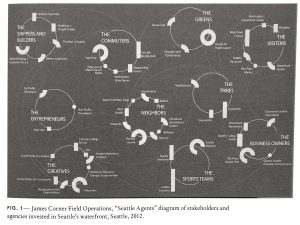
The final section, “Landscape Rethought,” examines concepts of territory and landscape perception. These essays investigate the multiscalar gaps between landscape represented as larger-scaled networked infrastructures and terrains, landscape as spatially experienced, and landscape as culturally constructed. In “Mapping in the Age of Electronic Shadows,” Alessandra Ponte discusses the proliferation of spatial data and visualization techniques that occur at the larger scale, lacking “material manipulations of geographic data” and presenting information as stagnant events. Drawing from Bruno Latour’s actor-network theory, Ponte calls for new tools that “draw together, materialize, simulate, and approximate what things are in all their materiality and conflicting nature . . . inviting designers to develop new ways of apprehending and charting (human and nonhuman) life and its (designed) milieu” (216.) She proposes that subjective and aesthetic mapping should move beyond the representation of networked territories to include “technical objects and living individuals” (224.) In contrast, in “Landscape as a Construct, Engineering as a Memory,” Adriaan Geuze uses the Netherlands’ history of landscape making to demonstrate that landscapes are constructed physically and culturally. The craft of engineering landscapes to cope with and prevent flooding became a symbol of cultural identity and pride. Geuze reflects, “In the idiosyncratic Dutch perception of nature, nostalgia and engineering are the same” (281.)
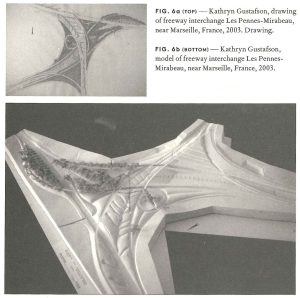
Cultural landscapes and landscape aesthetics are broad topics that have been thematically explored by many authors who have dedicated their careers to questioning how people interact with and manipulate their environments, such as J.B. Jackson in Landscapes (1970), Denis Cosgrove in Social Formation and Symbolic Landscape (1984), Simon Schama in Landscape and Memory (1996), and John Stilgoe in What is Landscape? (2015). Their work continues to influence landscape architecture by offering a range of perspectives for seeing the world and understanding our place in it, from the vernacular landscape to the representation of landscapes to what landscapes themselves represent. Although Thinking the Contemporary Landscape succeeds in providing a broad cross-section of the current questions and concerns within the discipline such as climate-change challenges and topics in cultural landscapes and aesthetics, as a collection it lacks depth in the exploration of such topics and questions. As the editors concede in their introduction, the book raises “more questions than it will bring answers” (10.) The objective of the book is clearly pertinent and essential in the field today, and the questions raised are valid, but this statement justifies the editors’ choice to prioritize breadth (more perspectives) over depth (extended pieces). Simultaneously, many of these questions concerning landscape aesthetics, culture, and social impacts have already arisen in the discipline as a critique of positivist approaches to landscape, and this volume is unsuccessful in venturing far beyond them in either asking or answering. For instance, in her 2008 essay Meyer asks, “Can landscape form and space indirectly, but more effectively, increase the sustainability of the bio-physical environment through the experiences it affords?”2 The editors seem to raise the question of bridging the gap between aesthetics/experience/formal and performative/systems-based/open-ended approaches, but few authors addressed this directly. Questions surrounding the role of aesthetics and poetics in contemporary landscape architecture, addressing a discipline grappling with larger scales and global challenges, are extremely timely, relevant, and necessary to continue to push disciplinary boundaries. These questions, however, need to be confronted head-on to create highly meaningful, functional, and performative cultural landscapes that engage in the complex challenges we face in this century.
How to Cite this Article: De Almeida, Catherine. Review of Thinking the Contemporary Landscape, by Christophe Girot and Dora Imhof, eds. JAE Online. July 17, 2018. http://www.jaeonline.org/articles/reviews-books/thinking-contemporary-landscape#/.
